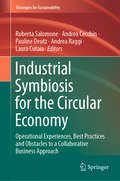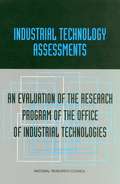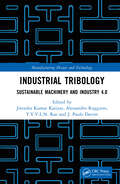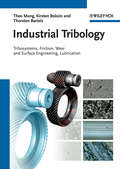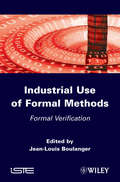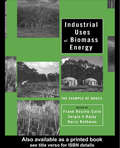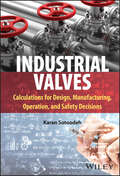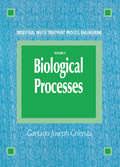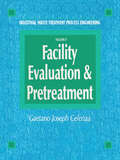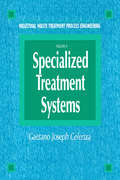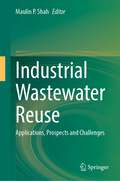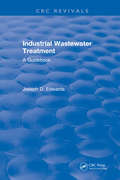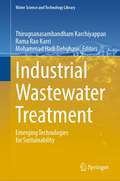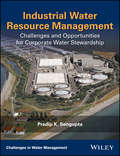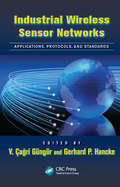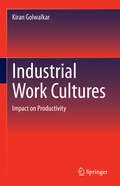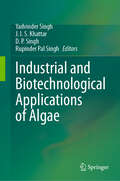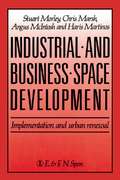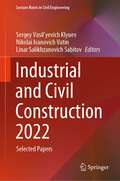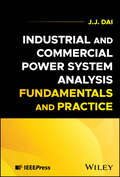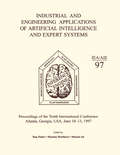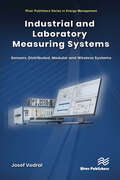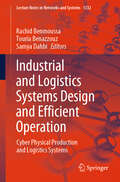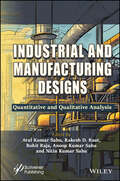- Table View
- List View
Industrial Symbiosis for the Circular Economy: Operational Experiences, Best Practices and Obstacles to a Collaborative Business Approach (Strategies for Sustainability)
by Roberta Salomone Andrea Raggi Andrea Cecchin Pauline Deutz Laura CutaiaThe book is designed to help public and private decision-makers and academics deepen their knowledge and understanding of the contexts, obstacles and challenges of a variety of business types involved in Industrial Symbiosis and Circular Economy practices.Industrial Symbiosis is reported in the Action Plan on the Circular Economy developed by the European Commission in 2015 (COM / 2015/0614 final) and in its revision of 14 March 2017, but relatively little is known of how these practices start, develop or fail, and mutate in a rapidly changing context.Including selected contributions presented at the 24th ISDRS 2018 Conference, “Actions for a Sustainable World: from theory to practice” in the two theme tracks “5c. Circular economy, zero waste & innovation” and “5g. Industrial symbiosis, networking and cooperation as part of industrial ecology”, this book offers a transdisciplinary perspective on real experiences of industrial symbiosis, performed both by industries and the scientific community, best practices, success and unsuccessful cases (implemented or under implementation), with the final aim to promote the adoption of Industrial Symbiosis as an operational and systematic tool for the Circular Economy. In particular, a focus on the environmental, social, and economic impact of Circular Economy and Industrial Symbiosis practices, and how those impacts may be context and/or scale dependent is given.
Industrial Technology Assessments: An Evaluation of the Research Program of the Office of Industrial Technologies
by Committee on Industrial Technology AssessmentsAn Evaluation of the Research Program of the Office of Industrial Technologies
Industrial Transformation: Implementation and Essential Components and Processes of Digital Systems (Advances in IoT, Robotics, and Cyber Physical Systems for Industrial Transformation)
by Om Prakash JenaThis book focuses on industrial development, design, implementation, and transformation using technologies such as Artificial Intelligence, Machine Learning, the Internet of Things (IoT), Big Data Analysis, and Blockchain. It incorporates complex processes, functions, and various other elements as one central component of digital systems. Industrial Transformation: Implementation and Essential Components and Processes of Digital Systems discusses the industry transformation aligned with the computerization of manufacturing and the required skills needed to build a new workforce. This book covers the role that AI plays in the management of resource flow and decision-making in the transformation of operations, as well as supply chain management. It presents sustainability and efficiency with IoT, Machine Learning, Data Analysis, and Blockchain technologies as it focuses on industrial development, design, and implementation. This book showcases the incorporation of complex processes and functions as one central component of digital systems and explores current trends that are working to accelerate industrial transformation. Case studies are also included, depicting the technologies that are influencing the transition into the fourth Industrial Revolution, such as industrial infrastructure, biodiversity, and enhanced productivity. This book is aimed at researchers, scholars, and students that require real-time knowledge and applications where the transformation and implementation of digital systems in the manufacturing sector are needed.
Industrial Tribology: Sustainable Machinery and Industry 4.0 (Manufacturing Design and Technology)
by J. Paulo Davim Jitendra Kumar Katiyar T.V.V.L.N. Rao Alessandro RuggieroCovering energy-saving technologies and how these are incorporated into component design, this book is relevant to many industries, including automotive engineering, and discusses the topical issue of sustainability in industry. This book details recent fundamental developments in the field of tribology in industrial systems.Tribology has advanced significantly in recent years. Tribological performance depends on external parameters such as contact pressure at the interface, system temperature, relative speed between bodies and contact behaviour. Through ensuring that mechanisms work in an energy-efficient manner and minimizing wear, engineers should seek to implement the study of tribology to improve the life of machinery within industry. Essential to the study of component design and condition monitoring, the book touches upon topics such as gears, bearings and clutches. Additionally, it discusses tribology’s relation to Industry 4.0 and incorporates the results from cutting-edge research.Industrial Tribology: Sustainable Machinery and Industry 4.0 will be of interest to all engineers working in industry and involved in mechanical engineering, material engineering, mechanisms and component design and automotive engineering.
Industrial Tribology: Tribosystems, Friction, Wear and Surface Engineering, Lubrication
by Kirsten Bobzin Theo Mang Thorsten BartelsIntegrating very interesting results from the most important R & D project ever made in Germany, this book offers a basic understanding of tribological systems and the latest developments in reduction of wear and energy consumption by tribological measures. This ready reference and handbook provides an analysis of the most important tribosystems using modern test equipment in laboratories and test fields, the latest results in material selection and wear protection by special coatings and surface engineering, as well as with lubrication and lubricants. This result is a quick introduction for mechanical engineers and laboratory technicians who have to monitor and evaluate lubricants, as well as for plant maintenance personnel, engineers and chemists in the automotive and transportation industries and in all fields of mechanical manufacturing industries, researchers in the field of mechanical engineering, chemistry and material sciences.
Industrial Use of Formal Methods: Formal Verification (Wiley-iste Ser. #693)
by Jean-Louis BoulangerAt present the literature gives students and researchers of the very general books on the formal technics. The purpose of this book is to present in a single book, a return of experience on the used of the “formal technics” (such proof and model-checking) on industrial examples for the transportation domain. This book is based on the experience of people which are completely involved in the realization and the evaluation of safety critical system software based. The implication of the industrialists allows to raise the problems of confidentiality which could appear and so allow to supply new useful information (photos, plan of architecture, real example).
Industrial Uses of Biomass Energy: The Example of Brazil
by Frank Rosillo-Calle Harry Rothman Sergio V. BajayIndustrial Uses of Biomass Energy demonstrates that energy-rich vegetation, biomass, is a key renewable energy resource for the future. Brazil, uniquely, has a recent history of large-scale biomass industrial uses that makes it a specially important test-bed both for the development of biomass technology and its utilisation, and for understanding h
Industrial Valves: Calculations for Design, Manufacturing, Operation, and Safety Decisions
by Karan SotoodehINDUSTRIAL VALVES Improve the design and safety of your industrial valves with this comprehensive guide Industrial valves are used to regulate the flow of liquids, gases, or slurries. They are fundamental to multiple industries, including marine shipping, in which valves regulate power supply, wastewater, water for fire-fighting, and other shipboard essentials. They are also critical to the oil and gas industry, where valves are used to control the flow of oil or gas out of deposits, direct the crude oil refining process, protect key areas and equipment from spillage and overflow, and more. Without the safety and regulating power provided by industrial valves these industries could not proceed. This book provides a thorough introduction to the modeling and calculation of key challenges related to valve design, manufacturing, and operation. It focuses particularly on solving problems of material failure due to corrosion and cavitation, allowing readers to construct valve designs that will maximize safety and reliability. It is a critical resource in helping protect workplaces, industrial sites, and valuable equipment from the externalities of these fundamental industrial resources. Readers will also find: Applied calculations based on real-life cases from industry Information based on international standards including NORSOK (Norwegian standard) and IECs (European standards) Based on decades of experience in the relevant industries Industrial Valves is a useful reference for engineers and practitioners in the oil and gas and marine industries, piping engineers, valve manufacturers, and more.
Industrial Waste Treatment Process Engineering: Biological Processes, Volume II
by Gaetano CelenzaIndustrial Waste Treatment Process Engineering is a step-by-step implementation manual in three volumes, detailing the selection and design of industrial liquid and solid waste treatment systems. It consolidates all the process engineering principles required to evaluate a wide range of industrial facilities, starting with pollution prevention and source control and ending with end-of-pipe treatment technologies.Industrial Waste Treatment Process Engineering guides experienced engineers through the various steps of industrial liquid and solid waste treatment. The structure of the text allows a wider application to various levels of experience. By beginning each chapter with a simplified explanation of applicable theory, expanding to practical design discussions, and finishing with system Flowsheets and Case Study detail calculations, readers can "enter or leave" a section according to their specific needs. As a result, this set serves as a primer for students engaged in environmental engineering studies AND a comprehensive single-source reference for experienced engineers. Industrial Waste Treatment Process Engineering includes design principles applicable to municipal systems with significant industrial influents. The information presented in these volumes is basic to conventional treatment procedures, while allowing evaluation and implementation of specialized and emerging treatment technologies.What makes Industrial Waste Treatment Process Engineering unique is the level of process engineering detail. The facility evaluation section includes a step-by-step review of each major and support manufacturing operation, identifying probable contaminant discharges, practical prevention measures, and point source control procedures. This theoretical plant review is followed by procedures to conduct a site specific pollution control program. The unit operation chapters contain all the details needed to complete a treatment process design.
Industrial Waste Treatment Processes Engineering: Facility, Evaluation & Pretreatment, Volume I
by Gaetano CelenzaIndustrial Waste Treatment Process Engineering includes design principles applicable to municipal systems with significant industrial influents. The information presented in these volumes is basic to conventional treatment procedures, while allowing evaluation and implementation of specialized and emerging treatment technologies.What makes Industrial Waste Treatment Process Engineering unique is the level of process engineering detail. The facility evaluation section includes a step-by-step review of each major and support manufacturing operation, identifying probable contaminant discharges, practical prevention measures, and point source control procedures. This theoretical plant review is followed by procedures to conduct a site specific pollution control program. The unit operation chapters contain all the details needed to complete a treatment process design.
Industrial Waste Treatment Processes Engineering: Specialized Treatment Systems, Volume III
by Gaetano CelenzaIndustrial Waste Treatment Process Engineering is a step-by-step implementation manual in three volumes, detailing the selection and design of industrial liquid and solid waste treatment systems. It consolidates all the process engineering principles required to evaluate a wide range of industrial facilities, starting with pollution prevention and source control and ending with end-of-pipe treatment technologies.Industrial Waste Treatment Process Engineering guides experienced engineers through the various steps of industrial liquid and solid waste treatment. The structure of the text allows a wider application to various levels of experience. By beginning each chapter with a simplified explanation of applicable theory, expanding to practical design discussions, and finishing with system Flowsheets and Case Study detail calculations, readers can "enter or leave" a section according to their specific needs. As a result, this set serves as a primer for students engaged in environmental engineering studies AND a comprehensive single-source reference for experienced engineers. Industrial Waste Treatment Process Engineering includes design principles applicable to municipal systems with significant industrial influents. The information presented in these volumes is basic to conventional treatment procedures, while allowing evaluation and implementation of specialized and emerging treatment technologies.What makes Industrial Waste Treatment Process Engineering unique is the level of process engineering detail. The facility evaluation section includes a step-by-step review of each major and support manufacturing operation, identifying probable contaminant discharges, practical prevention measures, and point source control procedures. This theoretical plant review is followed by procedures to conduct a site specific pollution control program. The unit operation chapters contain all the details needed to complete a treatment process design.Industrial Waste Treatment Process Engineering will interest environmental engineers, chemical process engineers working in environmental engineering, civil engineers with environmental specialties, as well as graduate students in environmental engineering, corporate environmental engineers, plant engineers, and industry and university technical libraries. These books supplement existing texts detailing the regulatory, legal, and permit preparation requirements imposed on manufacturing facilities. Additionally, Industrial Waste Treatment Process Engineering is designed for engineers preparing environmental appropriations for corporate funding and developing systems for plant facilities sensitive to operating costs.
Industrial Wastewater Reuse: Applications, Prospects and Challenges
by Maulin P. ShahThis book identifies emerging technologies that allow the reuse and regeneration of industrial wastewater with innovative and applied approaches throughout the wastewater treatment cycle. Today, it is increasingly clear that treated urban wastewater, whose reuse has become an important component of long-term water management worldwide, is a key source of chemical pollutants and emerging biological concerns. Current water-quality guidelines for reclaimed wastewater predominantly address the risks associated with the presence of microbial organisms and chemical parameters such as biological oxygen demand, chemical oxygen demand, E. coli and worms, and in some cases heavy metals; however, they are insufficient for the full evaluation of risks. The global growth of population is concentrated in urban areas; therefore, most of the challenges and solutions related to wastewater reside in urban treatment plants. Unless wastewater management and wastewater governance processes are significantly improved within a decade, it is likely that our societies will face severe and prolonged water insecurity and urban floods.The application of sustainable technologies can eliminate or minimize micro-contaminants in wastewater. Several organizations focus on the potential impacts to humans and their environments by wastewater reuse. This book gathers new research and reviews work from researchers and scientists to identify the main barriers and limitations that will need to be overcome, so that wastewater reuse strategies gain more momentum and will be adopted more efficiently worldwide.The book is designed for engineers, scientists, and other professionals who are seeking an excellent introduction to and basic knowledge of the principles of environmental bioremediation technologies.
Industrial Wastewater Treatment: A Guidebook
by J.D. EdwardsManaging wastewater is a necessary task for small businesses and production facilities, as well as for large industrial firms. Industrial Wastewater Treatment: A Guidebook presents an approach to successful selection, development, implementation, and operation of industrial wastewater treatment systems for facilities of all sizes. It explains how to determine various properties about wastewater, including how it is generated, what its constituents are, whether it meets regulatory requirements, and whether or not it can be recycled. It describes methodologies for developing and maintaining a suitable treatment program, determined by the type of company under consideration. Examples of treatment systems which have been installed in various types of businesses over the past several years are presented in a manner that clearly illustrates successful treatment methods.
Industrial Wastewater Treatment: Emerging Technologies for Sustainability (Water Science and Technology Library #106)
by Thirugnanasambandham Karchiyappan Rama Rao Karri Mohammad Hadi DehghaniThis book provides an overview of recent advances in technologies for water treatment processes, such as green technology, nano-adsorbents, photocatalysts, advanced oxidation, membranes separation and sustainable technologies. Advances in membrane technology and fabrication process is presented in detail. Latest approaches like microbial treatment, electro chemical and solar energy-based treatment techniques were presented. Also, the use of sustainable and energy efficient approaches were discussed.· The book presents the negative impact of inorganic and organic pollutants on the natural environment and human health. It describes and discussing the advanced membrane technologies, novel green adsorbents, microbial treatment techniques, electro chemical and solar based removal techniques It also compares the most effective methods of removing toxic contaminants from water solutions with the use of sustainable and energy efficient approaches It also presents the life cycle assessment of emerging technologies in industrial wastewater treatment and desalination as well as presents the benchmarking of energy efficiency during treatment process
Industrial Water Resource Management: Challenges and Opportunities for Corporate Water Stewardship
by Pradip K. SenguptaProvides the tools that allow companies to understand the fundamental concepts of water resource management and to take proper action towards sustainable development Businesses, communities, and ecosystems everywhere depend on clean freshwater to survive and prosper. When the same source of water is shared for economic, social, and environmental causes it becomes the responsibility of every sector to develop a sustainable water strategy beneficial for all. This book offers a water resource management plan for industries that is directly implementable and consistent with the Water Framework Directives of different countries with a special emphasis on developing countries—a plan that is economically efficient, socially equitable, and environmentally sustainable. Industrial Water Resource Management, Challenges and Opportunities for Efficient Water Stewardship offers explicit technical and investment solutions, socioeconomic and legal instruments, and recommendations for institutional restructuring. Written by a leading world expert in the field, it covers a wide range of topics including: ● Source water assessment and protection ● Water audit, industrial water footprint assessment—an evaluation of tools and methodologies ● Corporate water disclosure methods and tools ● Water stewardship by the industries ● Stakeholder collaboration and engagement ● New technologies enabling companies to better manage water resources Given the well-known challenge of managing natural resources in a way that maximizes and sustains social welfare, this book provides an invaluable point of reference for applied researchers and policy makers working in water resources management.
Industrial Wireless Sensor Networks: Applications, Protocols, and Standards (Industrial Electronics)
by V. Çağri Güngör Gerhard P. Hancke.The collaborative nature of industrial wireless sensor networks (IWSNs) brings several advantages over traditional wired industrial monitoring and control systems, including self-organization, rapid deployment, flexibility, and inherent intelligent processing. In this regard, IWSNs play a vital role in creating more reliable, efficient, and productive industrial systems, thus improving companies’ competitiveness in the marketplace. Industrial Wireless Sensor Networks: Applications, Protocols, and Standards examines the current state of the art in industrial wireless sensor networks and outlines future directions for research. What Are the Main Challenges in Developing IWSN Systems? Featuring contributions by researchers around the world, this book explores the software and hardware platforms, protocols, and standards that are needed to address the unique challenges posed by IWSN systems. It offers an in-depth review of emerging and already deployed IWSN applications and technologies, and outlines technical issues and design objectives. In particular, the book covers radio technologies, energy harvesting techniques, and network and resource management. It also discusses issues critical to industrial applications, such as latency, fault tolerance, synchronization, real-time constraints, network security, and cross-layer design. A chapter on standards highlights the need for specific wireless communication standards for industrial applications. A Starting Point for Further Research Delving into wireless sensor networks from an industrial perspective, this comprehensive work provides readers with a better understanding of the potential advantages and research challenges of IWSN applications. A contemporary reference for anyone working at the cutting edge of industrial automation, communication systems, and networks, it will inspire further exploration in this promising research area.
Industrial Work Cultures: Impact on Productivity
by Kiran GolwalkarThis book addresses technical issues and human factors mainly from the mechanical, chemical, electrical, metallurgical and civil engineering fields as these make significant contribution to the economy and progress of a nation. It discusses factors that assist development of efficient, ideal work cultures and their influence on the productivity. It addresses undesirable traits in the working personnel which can cause deviations from good working practices. Suggestions are given for encouraging better performance and corrective actions for improvement of unsatisfactory working.
Industrial and Biotechnological Applications of Algae
by D. P. Singh Yadvinder Singh J. I. S. Khattar Rupinder Pal SinghThis book discusses the diverse and promising uses of algae in various industries and biotechnological processes. Algae, as a photosynthetic organism, is found in varied habitats around the world. It has garnered significant attention in recent years due to its remarkable potential as a sustainable and environmentally friendly resource. This book aims to bridge the gap between scientific knowledge and practical applications by exploring the cutting-edge research, innovations, and emerging trends in the field of algal biotechnology. With a focus on both industrial and biotechnological aspects, this book delves into the wide array of applications that algae offers. From renewable energy and wastewater treatment to pharmaceuticals, nanomaterial, cosmetics, and personal care products, each chapter examines a specific area where its unique properties are harnessed to address pressing global challenges. Additionally, the book explores the role of algae in improving food production, supporting aquaculture, and contributing to carbon capture and utilization efforts. This book is a resource for scientists, researchers, industry professionals, and policymakers that highlights the potential of algae as a sustainable and versatile solution across multiple sectors. By presenting the latest advancements in algal biotechnology, the book seeks to inspire further research, foster innovation, and promote the integration of algae into mainstream industrial and biotechnological practices.
Industrial and Business Space Development: Implementation and urban renewal
by C. Marsh H. Martinos A. McIntosh S. MorelyAn insight into the changing nature of the industrial and business space property market and how business space development schemes can be initiated and implemented to revitalise urban areas.
Industrial and Civil Construction 2022: Selected Papers (Lecture Notes in Civil Engineering #436)
by Sergey Vasil’yevich Klyuev Nikolai Ivanovich Vatin Linar Salikhzanovich SabitovThis book gathers the latest advances, innovations, and applications in the field of construction engineering, as presented by researchers and engineers at the II International Conference “Industrial and Civil Construction”, held in Belgorod, Russia, on January 18-19, 2022. It covers highly diverse topics, including industrial and civil construction, theory and advanced technology of engineering structure, concrete technology, durable structures, smart structures and materials, and aggregates and processes in construction. The contributions, which were selected by means of a rigorous international peer-review process, highlight numerous exciting ideas that will spur novel research directions and foster multidisciplinary collaborations.
Industrial and Commercial Power System Analysis Fundamentals and Practice
by J. J. DaiUnderstand industrial and commercial power systems with this essential guide Power system analysis is an essential component of new system design, system expansion, and existing system operation. A wide range of published standards and computing tools is available for the analysis of industrial and commercial power systems. This is the first book to provide specific information and practical analysis. Industrial and Commercial Power System Analysis: Fundamentals and Practice fills this gap with a handy, accessible reference for students and practicing engineers. Its chapters cover basic equipment and system configurations and their associated computer models, operating conditions, numerical solution essentials, and analysis objectives and approaches. The result is a volume which directly contributes to the skills needed to apply power systems analysis software in research and industrial applications. Readers will also find: An introductory chapter outlining the basic characteristics of industrial and commercial power systemsDetailed discussion of topics including modeling and simulation techniques, data requirements and data preparation, tuning and validation, study scenario selections, and many moreApplicable industrial codes and standardsConcrete examples of industrial and commercial power system analysis in practice Industrial and Commercial Power System Analysis: Fundamentals and Practice is ideal for undergraduates, graduates, or practicing engineers looking for an up-to-date reference on the essential tools and standards of power system analysis.
Industrial and Engineering Applications of Artificial Intelligence and Expert Systems: Proceedings of the Tenth International Conference
by M. AliThis book presents the Proceedings of the Tenth International Conference on Industrial and Engineering Applications of Artificial Intelligence and Expert Systems, focusing on the theoretical aspects of intelligent systems research as well as extensions of theory of intelligent thinking machines.
Industrial and Laboratory Measuring Systems: Sensors, Distributed, Modular and Wireless Systems (River Publishers Series in Energy Management)
by Josef VedralThis book describes the types and properties of computer controlled industrial and laboratory measuring systems for data acquisition and the processing signals of typical physical sensors. It is intended for users and designers of digital measurement systems working in laboratories and industry, scientific and research environments, and students taking relevant courses.An overview of the properties of these sensors used in laboratory and industrial environments is provided. The chapters describe the properties of computers used in measurement systems, including plug-in cards and the IEEE-488 protocol. The following chapters describe the types and properties of distributed and modular measuring systems and systems using data networks, including wireless measuring systems. The final chapters describe methods of digitization, reconstruction and signal processing in measurement systems in time and frequency domains.
Industrial and Logistics Systems Design and Efficient Operation: Cyber Physical Production and Logistics Systems (Lecture Notes in Networks and Systems #1332)
by Rachid Benmoussa Touria Benazzouz Samya DahbiThis book aims to provide recent achievements in the efficient design and operation of industrial and logistics systems. To achieve excellence, digital transformation is currently an essential path for systems reengineering. This path is still in an exploratory phase for industrial and logistics systems, as they cover a wide range of sectors and are composed of several complementary views.Thus, this book reconciles classic methods with modern ones based on digital transformation and Industry 4.0 technologies, which aim to optimize, improve, restructure, and evaluate a broad scope of systems, focusing on their four complementary views: operational, informational, technological, and decisional.It is intended for researchers and postgraduates in industrial engineering and logistics, professionals in senior management positions in industrial and logistics companies, as well as undergraduates in industrial and logistics engineering programs.
Industrial and Manufacturing Designs: Quantitative and Qualitative Analysis
by Rohit Raja Nitin Kumar Sahu Atul Kumar Sahu Rakesh D. Raut Anoop Kumar SahuThis book promotes the idea of creative thinking to those working on qualitative and quantitative analysis for reinforcing engineering designs relating to industrial and manufacturing domains. The book focuses on the development of the theoretical foundations and discusses the utility of integration of critical components and systems engineering for effective systems design. The book presents research directions and can be used as a tool to understand in-depth possible ways related to the management of industrial and manufacturing activities, processes, actions, benchmarks, and so on. The new ideas, theories, and methods related to qualitative and quantitative research will improve manufacturing knowledge linked to the manufacturing process. Readers will find that the book: Explains qualitative and quantitative research for exploiting system characteristics and attaining system efficiency, as well as what decision-making tools are available for attaining sustainability in industrial fields; Discusses the utility of qualitative and quantitative models and analytical frameworks for enduring sustainability and the exploration of new ideas, critical theories, and methods related to qualitative and quantitative research; Disseminates industrial and manufacturing knowledge and allied boundaries, including case studies and sustainable ways to retain excellence in industrial and manufacturing domains based on qualitative and quantitative analysis; Presents critical aspects related to lean manufacturing and lean management tools, and demonstrates pure research and practical solutions to manufacturing problems; Offers theoretical content and demonstrations of manufacturing applications, as well as critical thinking and methodological support for optimizing resources and consumption; Reviews the development of supply chain network designs based on qualitative and quantitative aspects.
